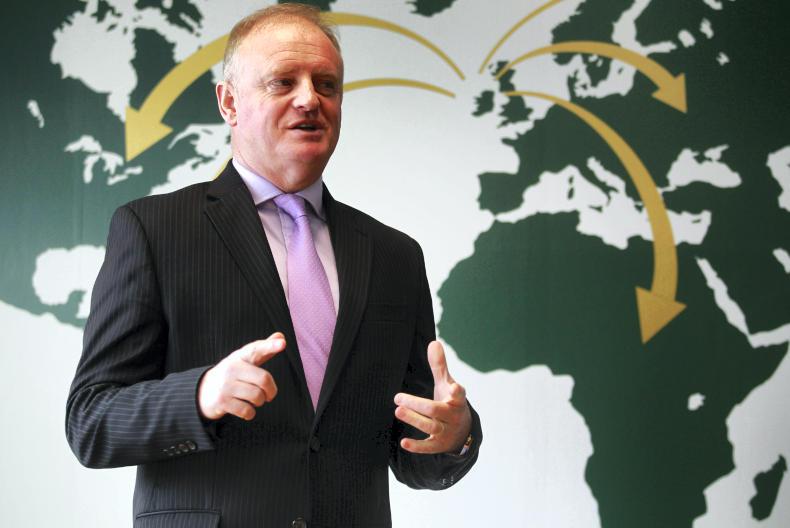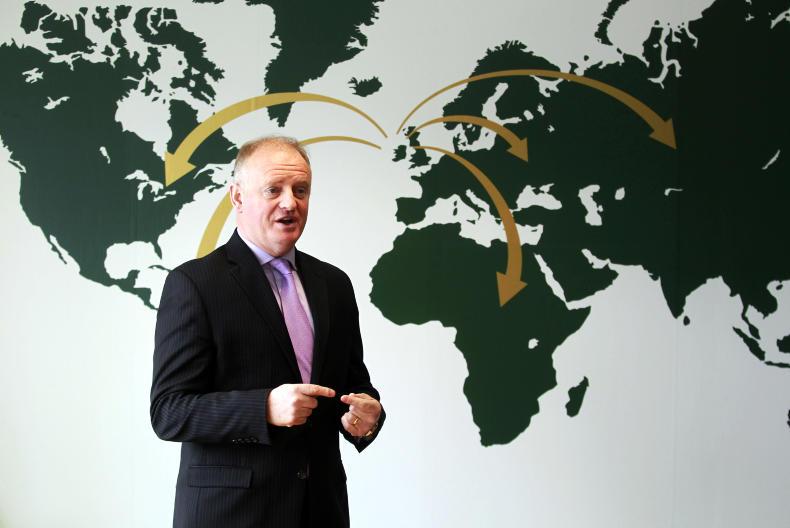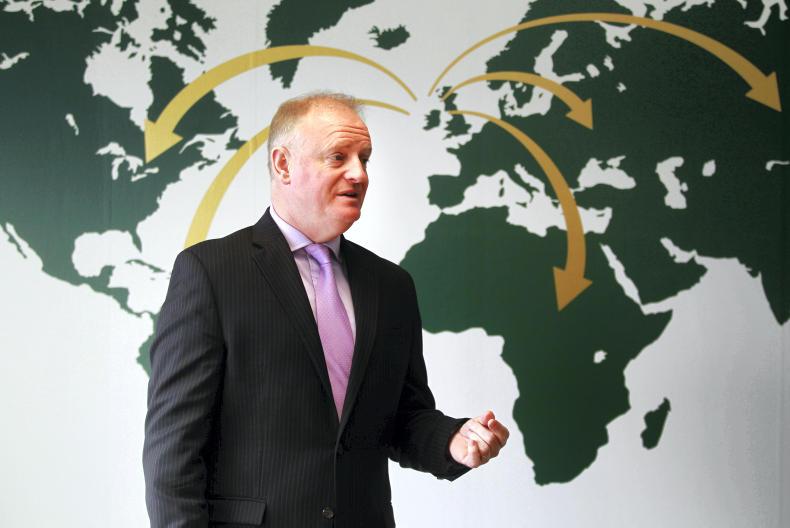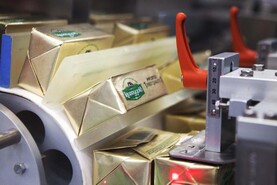It’s easy to forget how difficult it was to access markets and export food as a small island on the periphery of Europe before accessing the EU.
Back then Ireland was regarded by most of the global community as an almost insignificant island, still struggling to find its place in the world more than five decades after gaining independence from the UK.
When Ireland became a member of the EEC in 1973, it paved the way for Kerrygold butter to gain access to the highly lucrative German consumer. Today it is the number one butter brand sold in Germany.
Undoubtedly, the access provided by the European single market has facilitated the success of the Kerrygold brand.
For those agribusinesses concerned about trade barriers arising from Brexit, the Kerrygold story also illustrates how to overcome the challenges of barriers to trade.
Despite quotas and tariffs on imports into the US, it has become the number one imported brand in the US. It is now set to become Ireland’s first billion-dollar food brand.

Increasing awareness of the nutritional benefits of choosing butter from grass-fed cows has allowed Kerrygold to benefit from resurgence in butter sales.
When Time magazine published a front cover in 2014 exhorting its readers to eat butter, it sent a clear message in stating that butter is back.
It reinforced the trend among consumers that margarine was seen as less healthy and that consumers wanted natural, healthy and authentic foods.
This trend played right into Kerrygold’s message, which hasn’t changed since it was first launched in 1962.
Branding Irish food
While the original aim of the Kerrygold brand was to get beyond the commodity butter market and achieve a higher price, it has taught us much more about how to successfully brand and market an Irish food product.
Ornua has been consistent in all its years. Rather than promoting the provenance, Ornua’s strategy has been to promote the brand and its image of pure natural taste.
The Irishness of Kerrygold is secondary in its message to consumers.
Today’s consumer values honesty, integrity and authenticity. Kerrygold plays to these values.
With its distinctive yellow colour, coming from the milk of grass-fed cows along with its unique taste, consumers are willing to pay a premium for it.
The Kerrygold brand is only part of the Ornua story today. It now is a €2.5bn turnover business, exports 60% of Ireland’s milk to more than 110 countries and has 15 subsidiaries worldwide.
When Kevin Lane became CEO in 2009 the business had sales of €1.8bn, earnings of €56m and margins of 3%. His ambition is to grow revenues in the business to €3bn by 2021 while delivering a margin of 3%.
Growth of Ornua
Today, the branded side of the business, Ornua Foods, accounts for 55% of group turnover. However, Lane expects further growth to come from its brands and in particular through extension of the Kerrygold brand.

He wants to move Kerrygold from being a butter brand to a dairy brand by introducing new product formats and moving it out of the deli aisles and into the dairy aisles.
Currently the Kerrygold products sit in specialised areas of supermarkets, away from the chilled dairy cabinets.
He says this was one of the main reasons behind investing in processing butter in Ireland. Last year, Ornua invested €37m in a state-of-the-art butter facility in Mitchelstown.
One of the biggest challenges facing Lane is finding a home for the 50% expected growth in milk output from Irish dairy farmers.
As Ireland’s largest dairy exporter, Ornua handles 60% of Irish milk. The plan is to grow its markets in the years ahead with two main aims – marketing the extra product as well as adding extra value to it.
Ornua’s drive to secure new high-value outlets for Irish dairy products has seen the business make significant investments in the US, Germany, the UK, Saudi Arabia and Spain in recent years.
US market
The US is Ornua’s fastest-growing market where volumes in its consumer foods division grew a massive 39% in 2015. Last year it had sales in the US of $200m, with a target to grow this to $250m.
When combined with a growing US food ingredients division, Ornua’s US dairy operations will soon become a $0.5bn business. It plans to double the brand to 30,000t of butter in the next five to seven years. This is the equivalent of about 0.6m litres of Irish milk or 10% of the milk pool.
Given the importance of the US to Ornua, the protectionist noises coming from President Trump have to be a concern to Lane. He said right now Trump remains a watching brief and damages the potential for exports.
Closer to home, Lane is also grappling with the uncertainty created by Brexit. He says it means extra cost in terms of doing business in that market, which accounts for over 30% of Ornua’s sales.
He sees cheese as the highest risk, with 60% of Irish production ending up in the UK market. He adds that it has doubled its cheese sales to the US over the last two years. He is also concerned about an emerging buy-British consumer mentality in the UK.
At a time when Ornua is being supplied with more milk than ever before, much of its success in the future may be determined by forces outside its control. In the years ahead, Lane may have to navigate this business when trade with US and UK is more difficult coupled with weak dairy markets driven by oversupply and subdued demand.
What’s clear is that openness of trade is as relevant today for Ornua as it was back in 1973.
Read more
Ornua boss to step down
Milk prices hold for October
It’s easy to forget how difficult it was to access markets and export food as a small island on the periphery of Europe before accessing the EU.
Back then Ireland was regarded by most of the global community as an almost insignificant island, still struggling to find its place in the world more than five decades after gaining independence from the UK.
When Ireland became a member of the EEC in 1973, it paved the way for Kerrygold butter to gain access to the highly lucrative German consumer. Today it is the number one butter brand sold in Germany.
Undoubtedly, the access provided by the European single market has facilitated the success of the Kerrygold brand.
For those agribusinesses concerned about trade barriers arising from Brexit, the Kerrygold story also illustrates how to overcome the challenges of barriers to trade.
Despite quotas and tariffs on imports into the US, it has become the number one imported brand in the US. It is now set to become Ireland’s first billion-dollar food brand.

Increasing awareness of the nutritional benefits of choosing butter from grass-fed cows has allowed Kerrygold to benefit from resurgence in butter sales.
When Time magazine published a front cover in 2014 exhorting its readers to eat butter, it sent a clear message in stating that butter is back.
It reinforced the trend among consumers that margarine was seen as less healthy and that consumers wanted natural, healthy and authentic foods.
This trend played right into Kerrygold’s message, which hasn’t changed since it was first launched in 1962.
Branding Irish food
While the original aim of the Kerrygold brand was to get beyond the commodity butter market and achieve a higher price, it has taught us much more about how to successfully brand and market an Irish food product.
Ornua has been consistent in all its years. Rather than promoting the provenance, Ornua’s strategy has been to promote the brand and its image of pure natural taste.
The Irishness of Kerrygold is secondary in its message to consumers.
Today’s consumer values honesty, integrity and authenticity. Kerrygold plays to these values.
With its distinctive yellow colour, coming from the milk of grass-fed cows along with its unique taste, consumers are willing to pay a premium for it.
The Kerrygold brand is only part of the Ornua story today. It now is a €2.5bn turnover business, exports 60% of Ireland’s milk to more than 110 countries and has 15 subsidiaries worldwide.
When Kevin Lane became CEO in 2009 the business had sales of €1.8bn, earnings of €56m and margins of 3%. His ambition is to grow revenues in the business to €3bn by 2021 while delivering a margin of 3%.
Growth of Ornua
Today, the branded side of the business, Ornua Foods, accounts for 55% of group turnover. However, Lane expects further growth to come from its brands and in particular through extension of the Kerrygold brand.

He wants to move Kerrygold from being a butter brand to a dairy brand by introducing new product formats and moving it out of the deli aisles and into the dairy aisles.
Currently the Kerrygold products sit in specialised areas of supermarkets, away from the chilled dairy cabinets.
He says this was one of the main reasons behind investing in processing butter in Ireland. Last year, Ornua invested €37m in a state-of-the-art butter facility in Mitchelstown.
One of the biggest challenges facing Lane is finding a home for the 50% expected growth in milk output from Irish dairy farmers.
As Ireland’s largest dairy exporter, Ornua handles 60% of Irish milk. The plan is to grow its markets in the years ahead with two main aims – marketing the extra product as well as adding extra value to it.
Ornua’s drive to secure new high-value outlets for Irish dairy products has seen the business make significant investments in the US, Germany, the UK, Saudi Arabia and Spain in recent years.
US market
The US is Ornua’s fastest-growing market where volumes in its consumer foods division grew a massive 39% in 2015. Last year it had sales in the US of $200m, with a target to grow this to $250m.
When combined with a growing US food ingredients division, Ornua’s US dairy operations will soon become a $0.5bn business. It plans to double the brand to 30,000t of butter in the next five to seven years. This is the equivalent of about 0.6m litres of Irish milk or 10% of the milk pool.
Given the importance of the US to Ornua, the protectionist noises coming from President Trump have to be a concern to Lane. He said right now Trump remains a watching brief and damages the potential for exports.
Closer to home, Lane is also grappling with the uncertainty created by Brexit. He says it means extra cost in terms of doing business in that market, which accounts for over 30% of Ornua’s sales.
He sees cheese as the highest risk, with 60% of Irish production ending up in the UK market. He adds that it has doubled its cheese sales to the US over the last two years. He is also concerned about an emerging buy-British consumer mentality in the UK.
At a time when Ornua is being supplied with more milk than ever before, much of its success in the future may be determined by forces outside its control. In the years ahead, Lane may have to navigate this business when trade with US and UK is more difficult coupled with weak dairy markets driven by oversupply and subdued demand.
What’s clear is that openness of trade is as relevant today for Ornua as it was back in 1973.
Read more
Ornua boss to step down
Milk prices hold for October








 This is a subscriber-only article
This is a subscriber-only article









SHARING OPTIONS: